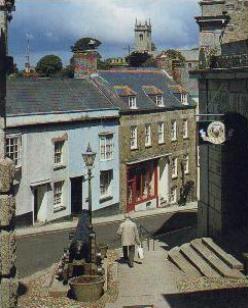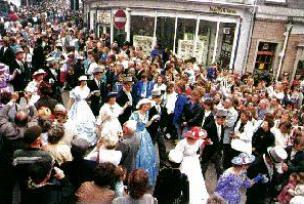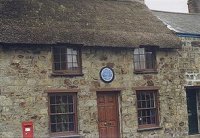


Home of the floral dance
Web: www.helston-online.co.uk
Web: www.discoverhelston.co.uk
Web: www.visitcornwall.com/destinations/helston
Helston is situated at the northern end of the Lizard Peninsula approximately twelve miles east of Penzance and nine miles south-west of Falmouth, on the A394 road. Helston is the most southerly town on the island of Great Britain and is around 1.5 miles farther south than Penzance. The population of the town was 10,909 at the 2011 census.
The town was granted a charter during the reign of King John in 1201, thus became a free borough town having certain privileges, the right to its own court being the most important. In these years, Helston had a castle - once the residence of Edmund, Earl of Cornwall - which was sited at the bottom of Coinagehall Street. A Charter of 1305 granted by King Edward made Helston one of the five Coinage Towns in Cornwall. It was a Coinage Town returning two members of Parliament until 1832, when the Reform Bill was proposed, reducing the number to one. In 1336 another Charter was granted. This gave the town a weekly market and four annual fairs. The income from the market and fairs helped considerably with the finances of the town.
At the bottom of Coinagehall Street, by Helston Bowling Club, there is a majestic Victorian Gothic gate-like structure. This is the Grylls Monument. Humphry Millet Grylls was a Helston banker and solicitor who saved 1200 jobs when he took action keep the local Wheal Vor tin mine open during the recession of 1820. He was also alderman of the borough and four-times mayor.
Humphry died on the 17th April 1834 at the age of 45, and it’s reported that he was so popular his funeral procession snaked for two miles from his home in Bosahan to Helston Church. 2,386 people gave money for this neo-Gothiic archway to be built at a cost of £324. The granite ashlar structure was erected in 1834 and 196 tons of local granite was used in its construction.
The town stands on the east bank of the River Cober which was once tidal, before it was cut from the sea by Loe Bar in the 13th century. According to some sources, Helston with a population then of about 200, was a small port which exported tin and copper. The Penrose Estate, owned by The National Trust, sits alongside The Loe Pool, a large freshwater lake, and has some beautiful waterside walks down to Loe Bar.
Round about 8th May each year there is the world famous festival known as Flora Day, otherwise "Furry Day" with its picturesque "Furry Dance", in which long lines of people with their hands joined make their way with rhythmic motion through the streets and indeed the houses also. Thousands of visitors throng the streets all day and there's a carnival atmosphere from dawn to well into the night. The custom is by some authorities considered to be a survival of the Roman occupation.

Many trades and professions were in operation during the mining boom of the early 19th century, and evidence of these and former industries can be found in the Helston Museum.
The Monument at the end of Coinagehall Street was built in 1834 to the memory of Humphry Millet Grylls, a Helston banker and solicitor whose actions kept open the local tin mine, Wheal Vor, and saved 1200 jobs.
Walking up Coinagehall Street, you will pass the The Blue Anchor Inn, a thatched building, originally a monks' rest house, which became a tavern in the 15th century. Miners received their wages in the pub, which is possibly the oldest private brewery in the country, call in and enjoy the local brew, Spingo! Further up, you'll find one of the oldest buildings in Helston, the The Angel Hotel, the former town house of the celebrated Godolphin family who represented Helston in Parliament for many years.

A plaque on the wall of one Wendron Street cottage marks the birthplace of Bob Fitzsimmons. Born in 1863, he was the first man to be world middleweight, light heavyweight and heavyweight boxing champion. He retired in 1914 and died in Chicago three years later.
St. Michael's Church was struck by lightning in 1727 and rapidly fell into disrepair. The townspeople were not in the position financially to restore the church and appealed to Francis, Earl of Godolphin for help. He then undertook to pay for the entire cost of the rebuilding, which amounted to around £6,000. The church was re-opened for divine worship on the 18th of October 1761. The church now has a granite Gothic tower of about 1830 and south porch to match. In the surrounding graveyard there is a monument to Henry Trengrouse (1772-1854), the inventor of the rocket fired safety line — a device for aiding in the saving of lives in a shipwreck.
Helston is ideally situated for anyone exploring the west of the county, with the Lizard, Penzance, Falmouth and Truro all within easy access. Other local attractions include the Royal Naval Air Station Culdrose famous for its air-sea rescue helicopters, Goonhilly Earth Satellite Station, Flambards Theme Park, The Poldark Mine at Wendron, and Bonython Estate Gardens. An ancient market town built on two hills, Helston has much to offer the tourist.
Helston used to have a railway station served from branch line off the main line through Cornwall, which opened in 1887 but was closed in 1962. The Helston Railway was re-opened by the Helston Railway Preservation Society in 2011.
Unfortunately through decline and the outbreak of foot and mouth disease, Helston Cattle Market closed in February 2001. The area once occupied by the market has been incorporated into Coronation Park, where there is also a skate park and a community building aptly named The Old Cattle Market; these, together with a Lakeside Café, afford perfect leisure facilities.
The local leisure centre is in Church Hill, TR13 8YQ.
The town's Tourist Information Centre is at 79 Meneage Street, TR13 8RB.
The Heritage Trail will take you through the historic streets and along hidden opes whilst recounting some of the amazing stories and myths of Helston past – a fascinating journey.
Henry Trengrouse, (1772-1854) Born in Helston, was the inventor of ship to shore rocket line.
Bob Fitzsimmons, (1863-1917) World Champion Boxer born in Helston.
Claude Brian Stevens, (1941-2017) Known as "Stack Stevens", born at Godolphin, near Helston, rugby player who won 25 caps for England.
Sidney Godolphin, (1645-1712) Served as Lord of the Treasury was born at Godolphin near Helston.
John Carter, (1770-1807) Born at Breage near Helston, he matured to become one of the biggest smugglers on the coast, the self styled King of Prussia.
Dr William Oliver, (1695-1764) from nearby Trevarno invented the Bath Oliver Biscuit in 1750.
Medwyn Goodall, (1961-) a musician from Yorkshire has lived and worked in Helston for many years.
Humphry Millet Grylls, (1789-1834) a banker and solicitor from Helston.
Flora Day- 8th May.
Bude Jazz Festival - End August.
Helston Fat Stock Show - Early November.
Christmas Lights Switch-On - End November.
Helston Castle Helston Museum The Homestead Woodland Garden The Poldark Mine Stithians Flora Day
Carminowe Valley Garden Penryn Porthleven Bosahan Garden Lizard Peninsula Trevarno Estate and Gardens
Helston Railway Godolphin House National Seal Sanctuary Pemboa Vineyard Trelowarren House The Penrose Estate
Clowance Estate Royal Naval Air Station Culdrose Goonhilly Earth Satellite Station Flambards Bonython Estate Gardens